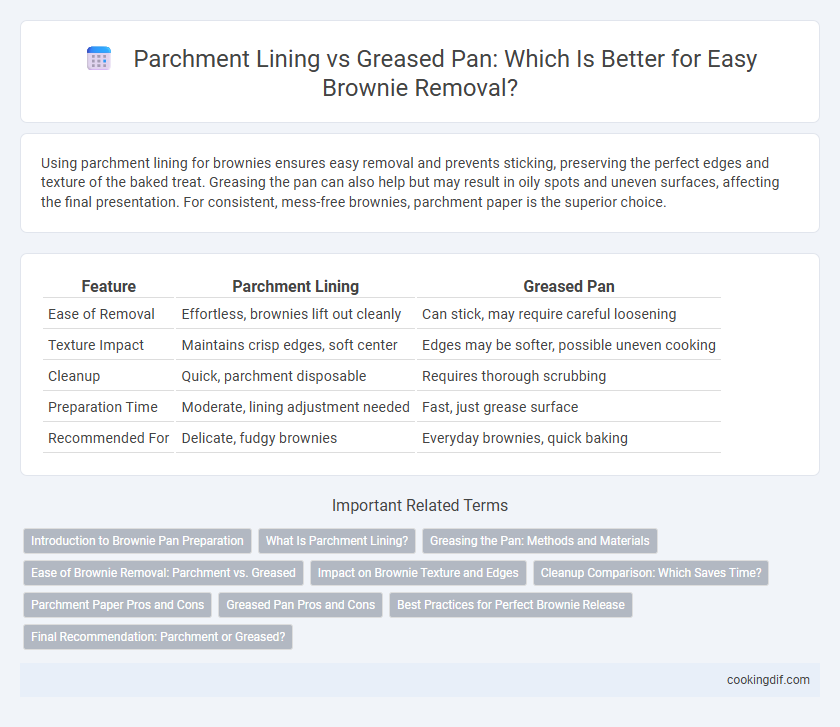Using parchment lining for brownies ensures easy removal and prevents sticking, preserving the perfect edges and texture of the baked treat. Greasing the pan can also help but may result in oily spots and uneven surfaces, affecting the final presentation. For consistent, mess-free brownies, parchment paper is the superior choice.
Table of Comparison
| Feature | Parchment Lining | Greased Pan |
|---|---|---|
| Ease of Removal | Effortless, brownies lift out cleanly | Can stick, may require careful loosening |
| Texture Impact | Maintains crisp edges, soft center | Edges may be softer, possible uneven cooking |
| Cleanup | Quick, parchment disposable | Requires thorough scrubbing |
| Preparation Time | Moderate, lining adjustment needed | Fast, just grease surface |
| Recommended For | Delicate, fudgy brownies | Everyday brownies, quick baking |
Introduction to Brownie Pan Preparation
For optimal brownie pan preparation, parchment lining provides a non-stick surface that ensures easy removal and clean edges, reducing the risk of broken or crumbly pieces. Greasing the pan with butter or oil also aids in preventing sticking but may result in slightly oily brownie edges. Utilizing parchment paper combined with light greasing maximizes convenience and preserves the desired texture of homemade brownies.
What Is Parchment Lining?
Parchment lining is a non-stick, heat-resistant paper used to line baking pans for easy brownie removal without sticking or breaking. It creates a smooth, non-greasy surface that helps brownies come out cleanly and maintain their shape. Using parchment paper eliminates the need for greasing and reduces mess, ensuring even baking and perfect brownie edges.
Greasing the Pan: Methods and Materials
Greasing the pan effectively involves using butter, shortening, or non-stick cooking spray to create a barrier that prevents brownies from sticking. Applying a thin, even layer with a pastry brush or paper towel ensures uniform coverage, improving the ease of removal. For extra assurance, dusting the greased surface lightly with cocoa powder or flour can further reduce sticking and maintain the brownie's texture.
Ease of Brownie Removal: Parchment vs. Greased
Parchment lining ensures effortless brownie removal by creating a non-stick barrier that prevents sticking and allows the entire brownie slab to lift out cleanly. A greased pan can help reduce sticking, but brownies often cling to the edges or bottom, leading to broken pieces and uneven removal. Using parchment paper significantly improves texture preservation and presentation by minimizing surface contact and ensuring smooth separation.
Impact on Brownie Texture and Edges
Parchment lining prevents brownies from sticking, ensuring clean edges and maintaining a fudgy, moist texture by reducing direct contact with the pan. Greased pans create a slight crust on the edges, offering a chewier bite but risking crumbly sides if over-greased. Choosing parchment enhances uniform softness, while greasing emphasizes crispier, more defined edges.
Cleanup Comparison: Which Saves Time?
Parchment lining significantly reduces cleanup time for brownies by preventing batter from sticking to the pan, allowing for easy removal and minimal residue. In contrast, greased pans often require scrubbing to remove baked-on grease and crumbs, which prolongs cleaning. Choosing parchment paper streamlines the baking process, making post-bake cleanup faster and more efficient.
Parchment Paper Pros and Cons
Parchment lining ensures easy removal of brownies by creating a non-stick surface that prevents edges from sticking to the pan, reducing the risk of breaking during extraction. It also simplifies clean-up and maintains the shape and texture of the brownies without adding extra fat or oil. However, parchment paper can sometimes tear or shift during pouring, and if not sized correctly, it may cause uneven baking or browning along the edges.
Greased Pan Pros and Cons
Greased pans create a rich, caramelized edge on brownies, enhancing flavor and texture, but they may cause difficulty in removal or uneven surfaces if not greased properly. This method simplifies preparation by eliminating the need for extra materials like parchment paper, but it requires careful application of butter or oil to avoid sticking or burning. Greasing also allows for a crisper crust, though it may reduce the uniformity of the bottom layer compared to parchment lining.
Best Practices for Perfect Brownie Release
For perfect brownie release, using parchment lining outperforms greased pans by creating a non-stick surface that ensures brownies lift cleanly without sticking or breaking. Parchment paper also simplifies cleanup and maintains the integrity of delicate crusts, making it a top choice among bakers. While greasing pans can work, it often leads to uneven cooking and stickiness, reducing the overall quality and appearance of the brownies.
Final Recommendation: Parchment or Greased?
Using parchment lining for brownies ensures effortless removal and prevents sticking, maintaining the cake's edges intact without crumbling. Greasing the pan can work but often leads to uneven surfaces and potential sticking, especially with fudgy brownie recipes. For a consistently smooth release and cleaner presentation, parchment-lined pans are the preferred choice among professional bakers.
Parchment lining vs greased pan for easy removal Infographic

 cookingdif.com
cookingdif.com